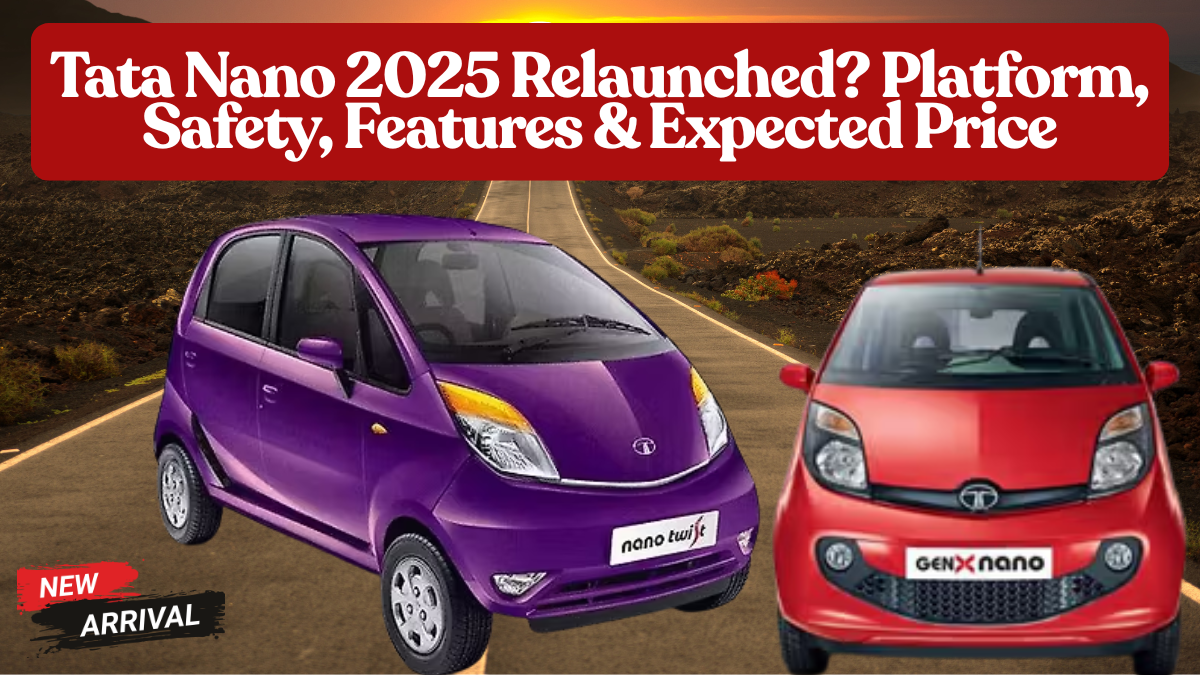The Tata Nano 2025 relaunch rumors have once again taken the Indian auto industry by storm. Once dubbed as the “people’s car,” the Tata Nano was originally designed to make car ownership accessible to millions. Now, with the electric revolution transforming India’s mobility scene, Tata Motors is reportedly reimagining the Nano concept for 2025 — this time as a smart, compact, and eco-friendly EV rather than a low-cost petrol microcar.
Let’s dive into what we know so far about the potential Tata Nano 2025 relaunch, including expected specifications, design changes, platform details, safety features, and estimated pricing.

The Nano Legacy and Its Rebirth
The original Tata Nano, launched in 2008, was an ambitious project that aimed to put India on four wheels. Despite its innovation, the Nano struggled due to perception issues and minimalistic design. However, in the EV era, the concept of a compact, efficient city car fits perfectly into current market demand.
Tata Motors has already found success with its electric lineup — Tiago EV, Tigor EV, and Nexon EV — which has strengthened consumer trust in Tata’s electric mobility. Industry insiders suggest that Tata could revive the Nano brand as an affordable city EV, focusing on practical range, modern features, and improved build quality.
This potential relaunch aligns with Tata’s goal to democratize electric cars under ₹10 lakh and expand EV adoption beyond metro cities.
Platform and Engineering
If relaunched, the Tata Nano 2025 EV is expected to use a heavily modified version of the Sigma platform, derived from the company’s Ziptron EV architecture. This will allow integration of a compact battery pack, lightweight chassis, and improved crash protection.
To maintain affordability, Tata may retain the Nano’s rear-wheel-drive layout but update it with independent rear suspension and front McPherson struts for better ride comfort. The wheelbase is likely to remain around 2,230 mm, providing just enough room for four adults while keeping the car extremely maneuverable in tight city traffic.
The ground clearance is expected to increase slightly to around 165 mm, improving usability on uneven roads. The Nano 2025 will focus on improved NVH (Noise, Vibration, Harshness) levels and stronger chassis rigidity to address one of the key weaknesses of its predecessor.
Design and Exterior Upgrades
Visually, the Tata Nano 2025 will retain the compact charm of the original model but with a modern twist. Expect sleeker LED headlamps, a closed-off EV grille, and sportier bumpers. The sides will feature aerodynamic creases, larger alloy wheels, and flush door handles.
At the rear, redesigned C-shaped LED tail lamps, a roof-mounted spoiler, and a clean rear fascia will give the Nano a futuristic appeal. Tata may even introduce a dual-tone color scheme with youthful shades such as Electric Blue, Copper Orange, and Glacier White to attract younger buyers.
Despite its compact footprint, the Nano’s tall-boy design ensures good visibility and easy ingress-egress, which remains one of its most practical strengths.
Battery, Range, and Performance
The heart of the Nano 2025 EV will likely be a 21–24 kWh lithium-ion battery pack, optimized for urban mobility. With Tata’s Ziptron efficiency tuning, it is expected to deliver a real-world range of around 220–250 km per charge, making it ideal for city commuters.
Charging time will vary depending on the method:
-
Standard AC home charger (3.3 kW): 6–7 hours for a full charge
-
DC fast charger (15–25 kW): 10% to 80% in about 60 minutes
The electric motor, possibly mounted at the rear, could generate around 35–40 bhp and 90 Nm of torque, ensuring peppy performance for city use. Acceleration from 0–60 km/h in under 6 seconds would make it quick enough for urban driving while remaining highly efficient.
Safety Improvements
Safety — a major concern with the original Nano — will be a key area of improvement in the 2025 version. Tata is expected to incorporate reinforced high-tensile steel in the chassis and adopt crumple zone architecture similar to that of the Tiago EV.
The Nano EV 2025 is also expected to include essential safety features such as:
-
Dual airbags
-
ABS with EBD
-
Reverse parking sensors and camera
-
Seat-belt reminders
-
Tyre pressure monitoring system (TPMS)
-
ISOFIX child seat anchors
The car’s battery pack will be IP67-rated for dust and water resistance and will include thermal management systems with automatic cut-off in case of overheating.
Interior and Features
The interior of the Tata Nano 2025 will undergo a complete transformation from the minimalist cabin of the original model. Expect a dual-tone dashboard, touchscreen infotainment system, and digital instrument cluster.
Likely features include:
-
7-inch infotainment touchscreen with wireless Android Auto and Apple CarPlay
-
Power windows and central locking
-
Automatic climate control
-
Push-button start
-
Connected car features via Tata iRA app (location tracking, charge monitoring, and remote AC control)
-
USB-C charging ports
-
Electric ORVMs and a multi-function steering wheel
Tata will prioritize space efficiency, so expect clever storage pockets, a flat floor, and foldable rear seats for additional luggage capacity.
Expected Price and Launch Timeline
If launched, the Tata Nano 2025 EV will aim to be India’s most affordable electric car, targeting an ex-showroom price between ₹6.5 lakh and ₹8.5 lakh, depending on battery size and variant.
The entry-level variant could offer a smaller 19 kWh battery, while a long-range version may use the full 24 kWh pack. With subsidies under FAME-II and state EV policies, the effective on-road price could drop to as low as ₹6 lakh in some regions.
While Tata Motors has not made an official announcement yet, sources suggest a possible launch window between July and October 2025, aligning with the festive season and increasing EV market momentum.
Competition and Market Impact
If launched, the Nano 2025 EV will compete with entry-level models such as the MG Comet EV, PMV EaS-E, and Tata Tiago EV. Its combination of low cost, compact size, and efficient battery will appeal to first-time car buyers, small business owners, and city commuters.
The Nano’s relaunch could also boost Tata’s presence in Tier-2 and Tier-3 markets where affordable EV adoption is rapidly growing. Given Tata’s extensive EV service network and reliable after-sales reputation, the Nano EV could play a pivotal role in India’s shift toward mass-market electric mobility.
Buyer’s Verdict
The idea of a Tata Nano 2025 EV is not just about reviving nostalgia — it’s about giving India an affordable, practical, and sustainable car for the future. If executed with better safety, modern tech, and real-world usability, the new Nano could finally fulfill the promise of being the true “people’s car.”
For urban families, small business owners, or anyone looking to enter the EV ecosystem without stretching their budget, the Nano EV could become an ideal choice. With its expected price point and Tata’s proven EV expertise, it has the potential to reshape India’s entry-level car segment once again.
FAQs
Is Tata Motors really relaunching the Nano in 2025?
While Tata has not officially confirmed it, multiple reports suggest the company is exploring a Nano EV relaunch under its affordable electric lineup.
What range can we expect from the Tata Nano 2025 EV?
The car is expected to offer a range of 220–250 km per charge, depending on driving conditions and battery size.
What will be the expected price of the Tata Nano 2025?
The Nano EV is likely to be priced between ₹6.5 lakh and ₹8.5 lakh (ex-showroom), making it one of the most affordable electric cars in India.
What battery and charging system will the Nano EV use?
It will use a 21–24 kWh lithium-ion battery pack, supporting DC fast charging (10%–80% in 60 minutes) and standard home charging in 6–7 hours.
What safety improvements will the 2025 Nano include?
The new version is expected to feature dual airbags, ABS, EBD, reinforced chassis, and IP67 battery protection, ensuring safety and reliability.
Click here to know more.
